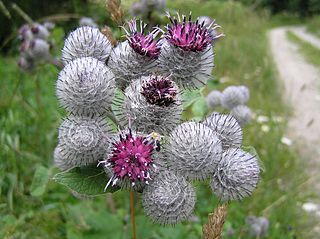
Branchiopoda is a class of crustaceans. It comprises fairy shrimp, clam shrimp, Diplostraca, Notostraca, the Devonian Lepidocaris and possibly the Cambrian Rehbachiella. They are mostly small, freshwater animals that feed on plankton and detritus.

Arctium is a genus of biennial plants commonly known as burdock, family Asteraceae. Native to Europe and Asia, several species have been widely introduced worldwide. Burdock's clinging properties, in addition to providing an excellent mechanism for seed dispersal, led to the invention of the hook and loop fastener.

Severo Ochoa de Albornoz was a Spanish physician and biochemist, and winner of the 1959 Nobel Prize in Physiology or Medicine together with Arthur Kornberg for their discovery of "the mechanisms in the biological synthesis of deoxyribonucleic acid (DNA)".

Serinus is a genus of small birds in the finch family Fringillidae found in West Asia, Europe and Africa. The birds usually have some yellow in their plumage. The genus was introduced in 1816 by the German naturalist Carl Ludwig Koch. Its name is Neo-Latin for "canary-yellow".

Remipedia is a class of blind crustaceans, closely related to hexapods, found in coastal aquifers which contain saline groundwater, with populations identified in almost every ocean basin so far explored, including in Australia, the Caribbean Sea, and the Atlantic Ocean. The first described remipede was the fossil Tesnusocaris goldichi. Since 1979, at least seventeen living species have been identified in subtropical regions around the world.

Myxophaga is the second-smallest suborder of the Coleoptera after Archostemata, consisting of roughly 65 species of small to minute beetles in four families. The members of this suborder are aquatic and semiaquatic, and feed on algae.

The Clostridiaceae are a family of the bacterial class Clostridia, and contain the genus Clostridium.

Speleonectidae is a family of remipedes in the order Nectiopoda. There are at least two genera and about seven described species in Speleonectidae.
The Gemmatimonadota are a phylum of bacteria established in 2003. The phylum contains two classes Gemmatimonadetes and Longimicrobia.

Helicoidea is a taxonomic superfamily of air-breathing land snails, terrestrial pulmonate gastropod mollusks in the clade Stylommatophora.

Bogidiella is a genus of crustacean in the family Bogidiellidae, containing the following species:

Aspiviridae, formerly Ophioviridae, is a family of segmented negative-strand RNA viruses which infect plants. Member viruses are characterized by an elongated and highly filamentous and flexible nucleocapsid with helical symmetry. It is a monotypic taxon containing only one genus, Ophiovirus. Aspiviridae is also the only family in the order Serpentovirales, which in turn is the only order in the class Milneviricetes.
Morlockia atlantida is a species of eyeless crustacean in the order Nectiopoda. It was discovered in August 2009 in the Túnel de la Atlántida, the world's longest submarine lava tube on Lanzarote in the Canary Islands off the west coast of North Africa. Originally named Speleonectes atlantida, it was transferred to genus Morlockia in 2012. Like other remipedes, the species is equipped with venomous fangs.

Bogidiellidae is a family of amphipod crustaceans, containing the following genera:
Paraperipatus is a genus of velvet worms in the family Peripatopsidae. The number of legs vary within species as well as among species in this genus and can range from as few as 21 pairs up to 27 pairs in males and 29 pairs in females. The maximum number of leg pairs recorded in this genus (29) is also the maximum number of leg pairs found in the family Peripatopsidae. This genus exhibits matrotrophic viviparity, that is, mothers in this genus retain eggs in their uteri and supply nourishment to their embryos, but without any placenta. Species in this genus are found in New Guinea and Maluku, Indonesia.

The clade Multicrustacea constitutes the largest superclass of crustaceans, containing approximately four-fifths of all described crustacean species, including crabs, lobsters, crayfish, shrimp, krill, prawns, woodlice, barnacles, copepods, amphipods, mantis shrimp and others. The largest branch of multicrustacea is the class Malacostraca.
Selvasaura is a genus of the lizard family Gymnophthalmidae. The genus contains three species.

Alfonso García-Valdecasas y García-Valdecasas was a Spanish professor of civil law, lawyer, politician, and founding member of the Falange Española.
The Eggerthellaceae are a family of Gram-positive, rod- or coccus-shaped Actinomycetota. It is the sole family within the order Eggerthellales.
Morlockiidae is a family of eyeless crustaceans in the order Remipedia. It contains one genus, Morlockia, which has 4 described species. The family was first described by Antonio García Valdecasas in 1984, during an expedition at the Jameos del Agua.











